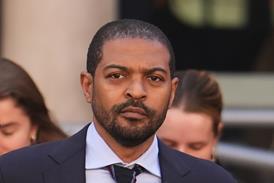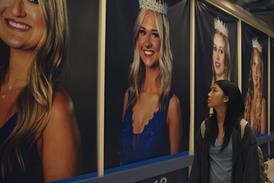Dir: Clint Eastwood. US.2006. 141mins.
Clint Eastwood's twilight career renaissancecontinues and only further deepens with LettersFrom Iwo Jima,his second film in two months about the best known Pacific battle duringWorld War Two. Shot back-to-back with its companion piece Flags Of Our Fathers, it focuses more explicitly on the conflictand its human toll, telling events leading up to the central siege from theJapanese perspective. Whereas its predecessor was very much about themachinations of government image-making and the media's complicity in wartime,this is more straightforwardly ruminative and plaintive.
Comparisons to Flags Of OurFathers are the natural benchmark, both artistically and in terms of box-officeappeal. While Flags is ostensibly themore naturally alluring picture, it has thus far stalled at under $35mdomestically. Told from a foreign perspective, and with Japanese dialoguethroughout, Letters FromIwo Jima lacks anarrative bent that suggests much better Stateside returns (it opens there onDec 20), making it a tough sell for mainstream audiences. Early criticalplaudits ' the film has been named best picture by both the Los Angeles FilmCritics Association and National Board of Review ' will help it with upscale arthouse patrons; parlaying that elite audience intosignificant box office, however, will seem an uphill climb.
Overseas may wellsee Letters FromIwo Jima give a betteraccount of itself, especially in Japan, where it opened on Dec 9.
Though the filmsdo not fit together seamlessly - nor are they necessarily meant to - they dostand next to one another in interesting fashion. But it is this second half ofEastwood's thematic double bill that is the more striking and memorable workand should push each project on to almost certain Oscar and Golden Globe nods. Certainlythe relative novelty and pluck of the endeavor should be enough to garnerEastwood, a beloved figure amongst AMPAS voters, strong consideration for yetanother Best Director Oscar nod. Letters'lack of commercial traction, however, will dent its chances at some top-shelfprizes, moreso after last season's Crash Oscar victory, which came amid thelowest-grossing, least populist Best Picture nominees in recent years.
The film opens inearly 1945. With an American beachhead assault on IwoJima looming, Japanese Lieutenant General Tadamichi Kuribayashi (Watanabe)is assigned to marshal forces and formulate a defensive strategy for the rockyPacific island.
More than 20,000Japanese soldiers have been sent to the atoll, knowing that they are unlikelyto survive. Among them are Saigo (KazunariNinomiya), a baker who only wants only to live to seethe face of his newborn daughter; Baron Nishi (Tsuyoshi Ihara), an Olympicequestrian champion known around the world for his skill and his honour; Shimizu (Ryo Kase), ayoung former military policeman whose idealism has not yet been tested by war;and Lieutenant Ito (Shidou Nakamura), an unyieldingand devoted military man who would rather commit suicide than surrender.
Kuribayashi's past travels across America, glimpsed inflashback, have shown him the hopeless nature of war, but also given him a strategicinsight into how to take on American forces that vastly outnumber his own.Against the vehement protests of his advisers, he orders his men to abandon theirshoreline defence structures and instead concentrateon the construction of a honeycomb of more than 18 miles of tunnels, caves andpillboxes, from which the much smaller Japanese forces can shrewdly targetAmerican troops.
The firsthour-plus of the film details in, if not languid, then certainly relaxedrhythms, the several weeks leading up to the battle, and it's here that most ofthe interesting characterisation can be found.
But when conflictcomes the situation changes, as the massive arrival ofAmerican forces provokes Japanese discord within the ranks, erupting inritualistic suicide and mutinous disobedience.
Several of thecombat scenes within Letters fitneatly into the chronology of Flags,but the lack of crossover cameos by significant Flags cast members or even many US soldiers ' indeed, the films arealmost wholly discrete experiences ' render these sequences somewhat hazy.Furthermore, Eastwood doesn't do a particularly keen job of establishing thespatial relationships necessary to make full, working sense of Kuribayashi's underground network.
There are someother intriguing parallels between the two movies, though, particularly withregards to the disparity between actuality and the public face that governmentsput on matters. Letters, though,doesn't plumb any representation of a spin machine; Kuribayashimerely receives dispassionate word via courier of his abandonment by varioussuperiors, and the fact that his forces will be bereft of air defence.
Whereas Flags sometimes struggled in juggling ofdifferent timelines, Eastwood's characteristically unembellished style isbetter naturally suited to Letters'story, which is more traditionally linear and character-driven.
Kazunari Ninomiya makesa nice impression as Saigo; although his arc isn'twildly cathartic, we see his cynical nature transform movingly into resolve. Asin The Last Samurai, Ken Watanabeprojects a preternatural calm and confidence, while also letting us see Kuribayashi's tender side. He and Tsuyoshi Ihara, who playserstwhile equestrian Nishi, provide the film with its moral gravity.
Technicalcategory awards nominations seem certain, withlongtime Eastwood collaborator and cinematographer Tom Stern's washed-out workdelivering an apocalyptic vision so desolate it makes one almost taste thesand.
Productioncompanies/backers
DreamWorks Pictures
Warner Bros. Pictures
Malpaso
Amblin Entertainment
US distribution
Warner Bros
Internationaldistribution
Warner Bros
Executiveproducer
Paul Haggis
Producers
Clint Eastwood
Steven Spielberg
Robert Lorenz
Screenplay
Iris Yamashita, from a story by Yamashita & Paul Haggis
Cinematography
Tom Stern
Production design
Henry Bumstead
James J Murakami
Editor
Joel Cox
Gary D Roach
Music
Kyle Eastwood
Michael Stevens
Main cast
Ken Watanabe
Kazunari Ninomiya
Tsuyoshi Ihara
Ryo Kase
Shidou Nakamura






















No comments yet